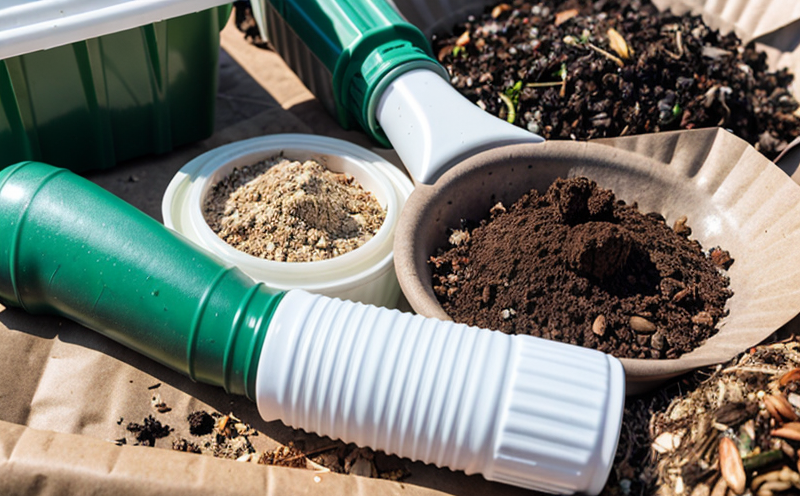ISO 15985 Anaerobic Biodegradation of Organic Waste under High-Solid Conditions
The ISO 15985 test standard is pivotal in the evaluation of biodegradable plastics and organic materials, particularly those intended for waste management and recycling. This method specifically assesses the anaerobic biodegradability of organic wastes under high-solid conditions, which are more representative of real-world landfill environments where oxygen is scarce.
The process involves incubating samples in a controlled environment designed to mimic the anaerobic conditions found in landfills. The test evaluates the rate and extent of biodegradation over time by measuring the loss of carbon dioxide (CO2) from the sample under these conditions. This method ensures that materials are not only compostable but also environmentally friendly, contributing significantly to waste management strategies.
Understanding this process is crucial for industries involved in developing sustainable products. For instance, manufacturers of bioplastics and compostable packaging must ensure their products meet stringent environmental standards before entering the market. By adhering to ISO 15985, these companies can verify that their materials will decompose effectively without causing harm to the environment.
The test protocol involves several key steps. Initially, the sample is prepared by drying and grinding it into a consistent particle size. This preparation ensures uniformity in the testing process, which is critical for accurate results. The samples are then inoculated with a mixed microbial culture designed to replicate landfill conditions. The incubation period can vary depending on the type of material being tested, but typically lasts several weeks.
During this time, CO2 production is monitored as an indicator of biodegradation. Advanced instrumentation such as gas chromatographs and mass spectrometers are used to quantify the amount of CO2 released. The data collected helps determine whether the material meets the required percentage of biodegradation within a specified timeframe.
The significance of this test lies in its ability to provide reliable evidence for the environmental impact of waste materials. Compliance with ISO 15985 ensures that products contribute positively to sustainable practices, thereby supporting broader environmental goals. This is particularly important given the growing emphasis on reducing plastic pollution and promoting circular economy principles.
For quality managers and compliance officers, this test offers a robust framework for ensuring product integrity. R&D engineers can leverage ISO 15985 to innovate new materials that meet both technological and environmental standards. Procurement teams benefit from knowing the exact specifications of biodegradable products they need, helping them make informed decisions about sourcing sustainable materials.
The test results are essential not only for regulatory compliance but also for brand reputation. Consumers increasingly demand eco-friendly products, making it imperative for businesses to demonstrate their commitment to sustainability through rigorous testing and certification processes.
Why It Matters
The ISO 15985 test is crucial in the context of waste management as it addresses a critical gap in existing standards. Many biodegradable materials are tested under aerobic conditions, which do not accurately reflect real-world scenarios where oxygen is limited or absent. By focusing on anaerobic degradation, this method provides a more realistic assessment of how these materials will behave in landfill environments.
The test also supports the development of new eco-friendly products by offering a standardized approach to evaluating their performance. This consistency ensures that all stakeholders—from manufacturers to regulators—are working towards common goals. The results can influence policy decisions and market trends, driving industries toward more sustainable practices.
Moreover, ISO 15985 helps bridge the gap between laboratory research and practical applications. By providing clear guidelines for testing, it facilitates better integration of scientific findings into product development cycles. This is particularly important in sectors like packaging where both functionality and environmental impact are paramount.
Benefits
The benefits of ISO 15985 testing extend beyond regulatory compliance; they offer significant advantages for businesses and the environment alike:
- Enhanced Product Integrity: Ensures that materials meet stringent environmental standards, enhancing brand reputation.
- Regulatory Compliance: Provides a standardized method for assessing biodegradability under anaerobic conditions, facilitating compliance with international regulations.
- Innovation Support: Encourages the development of new sustainable materials and processes.
- Consumer Confidence: Builds trust by demonstrating a commitment to environmental responsibility.
- Cost Efficiency: Helps businesses avoid costly mistakes by ensuring product design aligns with environmental goals from the outset.
- Market Differentiation: Offers a competitive edge in an increasingly environmentally conscious market.
- Sustainable Impact: Contributes to broader sustainability initiatives, reducing waste and promoting circular economy principles.
Environmental and Sustainability Contributions
The ISO 15985 test plays a vital role in advancing environmental sustainability by providing robust data on the biodegradability of organic materials under anaerobic conditions. This contributes to several key areas:
- Reduction in Landfill Burden: Ensures that waste decomposes effectively, reducing the need for landfills.
- Lower Greenhouse Gas Emissions: By promoting rapid and complete degradation, it helps mitigate methane emissions from landfills.
- Resource Conservation: Encourages the use of renewable resources in product design.
- Circular Economy Promotion: Supports the concept of waste as a resource by ensuring materials can be recycled or composted effectively.
- Policy Influence: Influences government policies aimed at reducing plastic pollution and promoting sustainable practices.
- Educational Value: Provides insights into material behavior, informing educational initiatives and research.
The results of ISO 15985 testing are valuable for both regulatory bodies and the private sector. They can inform policy decisions that drive industry towards more sustainable practices while also enabling businesses to make informed choices about their product offerings. This holistic approach ensures that every stakeholder benefits from a more environmentally friendly future.





